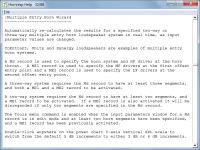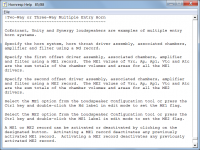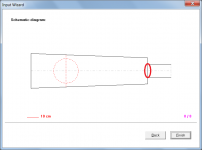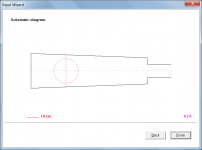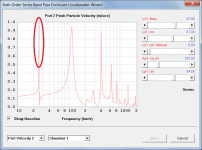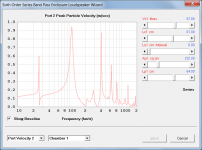Hi David.
It is a long time I was not here, busy with some amps designing and a smps for them, winding smps transformer is not quiote relaxed.
Oke, I have q question about a closed sub who has to radiate on the floor all around as a profect for a system with a dipole. Can I do simulate that in hornresp? a closed box does work. but needs it output on the floor.
Thanks
regards
It is a long time I was not here, busy with some amps designing and a smps for them, winding smps transformer is not quiote relaxed.
Oke, I have q question about a closed sub who has to radiate on the floor all around as a profect for a system with a dipole. Can I do simulate that in hornresp? a closed box does work. but needs it output on the floor.
Thanks
regards
I have q question about a closed sub who has to radiate on the floor all around as a profect for a system with a dipole.
Hi Kees,
If you are referring to a down-firing closed-box woofer, then it is not really possible to simulate such a system in Hornresp.
Kind regards,
David
one book to rule them all
It certainly covers things in much more detail than the classic chapters on horn loudspeakers in the two standard reference texts "Acoustical Engineering" by Harry Olson and "Acoustics" by Leo Beranek, and in the relatively recent updated version of "Acoustics" by Leo Beranek and Tim Mellow 🙂.
It certainly covers things in much more detail than the classic chapters on horn loudspeakers in the two standard reference texts "Acoustical Engineering" by Harry Olson and "Acoustics" by Leo Beranek, and in the relatively recent updated version of "Acoustics" by Leo Beranek and Tim Mellow 🙂.
I have the updated Beranek/Mellow version and the original. A complete text on the subject will be welcome.
The first horn calculations I worked through were in 1994 via a BASIC program that could generate tractrix profiles. But nothing else. Generate a table similar to Hornresp output but no simulation. So build measure and listen. We have come so much farther now. It's amazing really. Perhaps Bjorn will release his program?
Thanks to David for promoting the Book!
Have a read at what my co-author Thomas says about the theory section: Reading horn theory.
There are some sneak peaks from the history section on the website as well.
does it include math to english translations??
Have a read at what my co-author Thomas says about the theory section: Reading horn theory.
There are some sneak peaks from the history section on the website as well.
Perhaps Bjorn will release his program?
It all depends on available time, and how much time I want to spend in front of the computer. I have dozens of other projects that have been on hold while writing and that do not involve sitting in front of a screen. But eventually...
Thanks to David for promoting the Book!
I simply wanted people to be aware of the existence of the horn book website. There was no need for any promoting of the book by me - as can be seen from the information presented on the site, the quality of the book is such that it clearly speaks for itself.
It is interesting that "hornbooks" have been around for more than 500 years: Hornbook - Wikipedia 🙂.
It all depends on available time, and how much time I want to spend in front of the computer. I have dozens of other projects that have been on hold while writing and that do not involve sitting in front of a screen. But eventually...
You are preaching to the choir sir!
The greatest reason why I split my time between the professional consulting and working with my hands is variety. Keeps the brain a little better lubricated. Plus it constantly amazes me that when I'm working on different things I can come up with solutions to other problems.
Take your time. It will happen when you find it enjoyable. During those wonderful winters in Great Britain. 😱
Unity horn
Dave,
Could the Unity Horn be simmed in Hornresp? better yet 3 ways Unity where the woofer is in the horn? An example or link would be great. Thanks
Dave,
Could the Unity Horn be simmed in Hornresp? better yet 3 ways Unity where the woofer is in the horn? An example or link would be great. Thanks
Excellent. Just one possible caveat: there is a relatively rare family of tube amps that are OTL (output transformerless). Julius Futterman and Bruce Rosenblit seem to be the big names in this field.Perhaps I can be of assistance.
Tube amps are characterised by having transformers in the output stage, in order to adapt the tubes inherent high impedance to the loudspeakers inherent low impedance.
Transformers can not pass a DC voltage, which I am sure is your concern.
Thus, in such case, an isolating capacitor should not be necessary.
Single-ended transistor amplifiers already have an isolating capacitor in the output, so in this case too an extra capacitor should not be necessary.
Push-Pull transistor amplifiers however, deserves some attention:
Two output devices are suspended between the pos. and neg. supply rails respectively. If ONE of the devices (or associated circuitry) decides to blow, it is almost certain that the output will smack out to one or the other supply rail, depending on a short or an open circuit.
With such amp. it could be an idea to include an isolating capacitor indeed.
Strangely, one sometimes see mini-fuses on-board the PCB in each supply of the amplifier !
So a 50 cent fuse, deciding to blow, will fry a 500$ loudspeaker.
Ironically, class D amps actually do switch between supply rails, though very fast. An isolating/smoothing inductor keep things ample for loudspeaker use.
However, the class D amps I have worked with all had a high level and high frequency carrier superimposed to the output.
So a large voice coil inductance is definitely necessary to quench this and dissipate a few watts.
A woofers coil is probably OK for this, but a fine tweeter ?
I would´nt use class D amps for active filtering, except for woofers which I already do.
Could the Unity Horn be simmed in Hornresp? better yet 3 ways Unity where the woofer is in the horn?
Hi 1hiep0,
Both two-way and three-way systems can be simulated. A representative example of a multiple entry horn system can be specified using the Input Wizard accessed from under the Input Parameters window Help menu. The record parameter values can then be changed to match the actual design. Read the "Multiple Entry Horn Wizard" and "Two-Way or Three-Way Multiple Entry Horn" sections in the Help file to better understand how a multiple entry type system is specified in Hornresp.
Kind regards,
David
Attachments
difference?
Thank, I got that, essentially the same as Synergy Horn. I am wondering what is the difference as always thinking the Synergy is straight horn wall and Unity is curve horn wall.Read the "Multiple Entry Horn Wizard" and "Two-Way or Three-Way Multiple Entry Horn" sections in the Help ........
David
Read the patents and you will end up just as confused as the rest of us. The synergy patent appears to be an attempt to protect some of Toms IP after he moved from SPL to Danley Sound Labs. The Unity and Synergy patents are very similar. The Unity patent has now expired. I doubt the current patent could stand up to a challenge in court.
Hornresp Update 5040-190922
Hi Everyone,
BUG FIX 1
The following sequence of events would produce an incorrect schematic diagram for a mass loaded transmission line loudspeaker in the Input Wizard. This has now been fixed. Attachment 1 shows the incorrect schematic, Attachment 2 shows the correct schematic.
Free space
Next
Direct radiator
Next
Closed box
Next
Offset driver
Next
Back
Back
Transmission line
Next
Mass loaded
Next
Next
Next
Next
Incorrect schematic
BUG FIX 2
For band pass loudspeaker systems, the initial baseline port velocities were not exactly the same as those for the initial calculated results. This has now been fixed. Attachment 3 shows the incorrect results, Attachment 4 shows the correct results. In the correct results the grey baseline trace can no longer be seen because it is identical to, and hidden behind, the light red trace.
Kind regards,
David
Hi Everyone,
BUG FIX 1
The following sequence of events would produce an incorrect schematic diagram for a mass loaded transmission line loudspeaker in the Input Wizard. This has now been fixed. Attachment 1 shows the incorrect schematic, Attachment 2 shows the correct schematic.
Free space
Next
Direct radiator
Next
Closed box
Next
Offset driver
Next
Back
Back
Transmission line
Next
Mass loaded
Next
Next
Next
Next
Incorrect schematic
BUG FIX 2
For band pass loudspeaker systems, the initial baseline port velocities were not exactly the same as those for the initial calculated results. This has now been fixed. Attachment 3 shows the incorrect results, Attachment 4 shows the correct results. In the correct results the grey baseline trace can no longer be seen because it is identical to, and hidden behind, the light red trace.
Kind regards,
David
Attachments
Last edited:
Read the patents and you will end up just as confused as the rest of us. The synergy patent appears to be an attempt to protect some of Toms IP after he moved from SPL to Danley Sound Labs. The Unity and Synergy patents are very similar. The Unity patent has now expired. I doubt the current patent could stand up to a challenge in court.
I completely agree with your comment.
You can blame Tom for trying to get some sort of protection for his work. The true problem is that it really isn't really original in the sense that it hasn't been accomplished before. There many patents that are long expired that cover the various points of form and function that are used in the synergy loudspeakers.
Non-Issue
Tom Danley, besides being an accomplished acoustician, is a successful entrepreneur as well. A patent is normally written by a lawyer in legalese, not easily understood by a layman. The trade secrets, not disclosed there, are the design features that make a product a success and hard to copy. Tom's marked generosity in sharing these details with the public, is remarkable. In this setting, patent expiration is not a particularly relevant issue. WHG
I completely agree with your comment.
You can blame Tom for trying to get some sort of protection for his work. The true problem is that it really isn't really original in the sense that it hasn't been accomplished before. There many patents that are long expired that cover the various points of form and function that are used in the synergy loudspeakers.
Tom Danley, besides being an accomplished acoustician, is a successful entrepreneur as well. A patent is normally written by a lawyer in legalese, not easily understood by a layman. The trade secrets, not disclosed there, are the design features that make a product a success and hard to copy. Tom's marked generosity in sharing these details with the public, is remarkable. In this setting, patent expiration is not a particularly relevant issue. WHG
Tom Danley, besides being an accomplished acoustician, is a successful entrepreneur as well. A patent is normally written by a lawyer in legalese, not easily understood by a layman. The trade secrets, not disclosed there, are the design features that make a product a success and hard to copy. Tom's marked generosity in sharing these details with the public, is remarkable. In this setting, patent expiration is not a particularly relevant issue. WHG
Again I agree.
But the patent is a doozy. I have read many hundreds so understanding a patent is not new to me. Tom is a gifted designer and inventor. And I know of at least a few instances where Tom has been very helpful in making people understand what he is doing well enough to make some of his products in a similar fashion.
Being able to duplicate doesn't mean you have the same article. Nor does it really mean that you have a solid understanding on what design choices went into making the original work as it does.
In fact there are a few other multiple entry systems out there that have a similar if not same result in creating a unified point for the reproduction of sound. Two of them are well published on this website and one for sure was helped out my Tom himself. The other was a completely original design.
confuse
Understood. So if I copy one of Tom's design 1:1 it will never sound the same as the original.
Unity VS Synergy What is the {main difference} technically between them? I prefer Unity horn built, which doesn't violate Tom's patent. Now I am thinking they are the same if they looked the same as Tom's commercial then I may be violated.
Again I agree.
Being able to duplicate doesn't mean you have the same article. Nor does it really mean that you have a solid understanding on what design choices went into making the original work as it does.
Understood. So if I copy one of Tom's design 1:1 it will never sound the same as the original.
I read one of thread. But he was stating that none of the commercial available matching his {or the same as his} if I interpreted correctly.Two of them are well published on this website and one for sure was helped out my Tom himself. The other was a completely original design.
Unity VS Synergy What is the {main difference} technically between them? I prefer Unity horn built, which doesn't violate Tom's patent. Now I am thinking they are the same if they looked the same as Tom's commercial then I may be violated.
- Home
- Loudspeakers
- Subwoofers
- Hornresp

